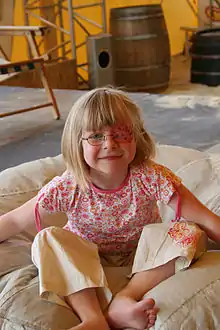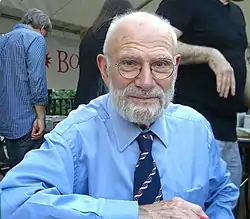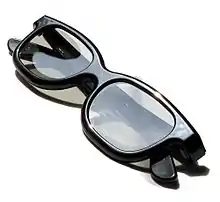Stereopsis recovery
Stereopsis recovery, also recovery from stereoblindness, is the phenomenon of a stereoblind person gaining partial or full ability of stereo vision (stereopsis).

Recovering stereo vision as far as possible has long been established as an approach to the therapeutic treatment of stereoblind patients. Treatment aims to recover stereo vision in very young children, as well as in patients who had acquired but lost their ability for stereopsis due to a medical condition. In contrast, this aim has normally not been present in the treatment of those who missed out on learning stereopsis during their first few years of life. In fact, the acquisition of binocular and stereo vision was long thought to be impossible unless the person acquired this skill during a critical period in infancy and early childhood.[1] This hypothesis normally went unquestioned and has formed the basis for the therapeutic approaches to binocular disorders for decades. It has been put in doubt in recent years. In particular since studies on stereopsis recovery began to appear in scientific journals and it became publicly known that neuroscientist Susan R. Barry achieved stereopsis well into adulthood, that assumption is in retrospect considered to have held the status of a scientific dogma.[2][3][4][5]
Very recently, there has been a rise in scientific investigations into stereopsis recovery in adults and youths who have had no stereo vision before. While it has now been shown that an adult may gain stereopsis, it is currently not yet possible to predict how likely a stereoblind person is to do so, nor is there general agreement on the best therapeutic procedure. Also the possible implications for the treatment of children with infantile esotropia are still under study.
Clinical management of strabismus and stereoblindness
In cases of acquired strabismus with double vision (diplopia), it is long-established state of the art to aim at curing the double vision and at the same time recovering a patient's earlier ability for stereo vision. For example, a patient may have had full stereo vision but later had diplopia due to a medical condition, losing stereo vision. In this case, medical interventions, including vision therapy and strabismus surgery, may remove the double vision and recover the stereo vision which had temporarily been absent in the patient.
Also when children with congenital (infantile) strabismus (e.g. infantile esotropia) receive strabismus surgery within the first few years or two of their life, this goes along with the hope that they may yet develop their full potential for binocular vision including stereopsis.
In contrast, in a case where a child's eyes are straightened surgically after the age of about five or six years and the child had no opportunity to develop stereo vision in early childhood, normally the clinical expectation is that this intervention will lead to cosmetic improvements but not to stereo vision. Conventionally, no follow-up for stereopsis was performed in such cases.
For instance, one author summarized the accepted scientific view of the time with the words: "Stereopsis will never be obtained unless amblyopia is treated, the eyes are aligned, and binocular fusion and function are achieved before the critical period for stereopsis ends. Clinical data suggest that this occurs before 24 months of age,[…] but we do not know exactly when it occurs, because crucial pieces of basic science information are missing."[6] For purposes of illustration, reference is made to a book of doctors' handouts for patients, written for the general public and published in 2002, which summarizes the limitations in the terms in which they, at the time, were fully accepted as medical state of the art as follows: "If an adult has a childhood strabismus that was never treated, it is too late to improve any amblyopia or depth perception, so the goal may be simply cosmetic – to make the eyes appear to be properly aligned – though sometimes treatment does enlarge the extent of side vision."[7] It has only been accepted very recently that the therapeutic approach was based on an unquestioned notion that has, since, been referred to as "myth" or "dogma".[5]
Recently, however, stereopsis recovery is known to have occurred in a number of adults. While this has in some cases occurred after visual exercises or spontaneous visual experiences, recently also the medical community's view of strabismus surgery has become more optimistic with regard to outcomes in terms of binocular function and possibly stereopsis.[8] As one author states:
- "The majority of adults will experience some improvement in binocular function after strabismus surgery even if the strabismus has been longstanding. Most commonly this takes the form of an expansion of binocular visual fields; however, some patients may also regain stereopsis."[9]
Scientific investigations on residual neural plasticity in adulthood now also include studies on the recovery of stereopsis. Now it is a matter of active scientific investigation under which conditions and to which degree binocular fusion and stereo vision can be acquired in adulthood, especially if the person is not known to have had any preceding experience of stereo vision, and how outcomes may depend on the patient's history of therapeutic interventions.
Examples and case studies

Stereopsis recovery has been reported to have occurred in a few adults as a result of either medical treatments including strabismus surgery and vision therapy, or spontaneously after a stereoscopic 3D cinema experience.
Personal reports in Fixing my Gaze
The most renowned case of regained stereopsis is that of neuroscientist Susan R. Barry, who had had alternating infantile esotropia with diplopia, but no amblyopia, underwent three surgical corrections in childhood without achieving binocular vision at the time, and recovered from stereoblindness in adult age after vision therapy with optometrist Theresa Ruggiero. Barry's case has been reported on by neurologist Oliver Sacks.[10] Also David H. Hubel, winner of the 1981 Nobel Prize in Physiology or Medicine with Torsten Wiesel for their discoveries concerning information processing in the visual system, commented positively on her case.[11] In 2009, Barry published a book Fixing My Gaze: A Scientist's Journey into Seeing in Three Dimensions, reporting on her own and several other cases of stereopsis recovery.[2]
In her book Fixing my Gaze, Susan Barry gives a detailed description of her surprise, elation and subsequent experiences when her stereo vision suddenly set in.
Hubel wrote of her book:
David H. Hubel, winner of the Nobel Prize in Physiology/Medicine, John Franklin Enders Professor of Neurobiology, Emeritus, Harvard Medical School.[2]
Her book includes reports of further persons who have had similar experiences with stereopsis recovery. Barry cites the personal experiences of several persons, including a man who was an artist and described his experience of seeing with stereopsis as "that he could see one hundred more times negative space",[12] a woman who had been amblyopic before seeing in 3D described how empty space now "looks and feels palpable, tangible—alive!",[13] a woman who had been strabismic since age two and saw in 3D after taking vision therapy and stated that "The coolest thing is the feeling you get being “in the dimension”",[14] a woman who felt quite alarmed at the experience of suddenly seeing roadside trees and signs looming towards her,[15] and two women who experienced an abrupt onset of stereo vision with a wide-angled view of the world, the first stating: "I was able to take in so much more of the room than I did before" and the second: "It was very dramatic as my peripheral vision suddenly filled in on both sides".[16]
Common to Barry and at least one person on whom she had reported is the finding that also their mental representation of space changed after having acquired stereo vision: that even with one eye closed the feeling is to see "more" than seeing with one eye closed before recovering stereopsis.[16]

Further cases in the media
Apart from Barry, another formerly stereoblind adult whose acquired ability for stereopsis has received media attention is neuroscientist Bruce Bridgeman, professor of psychology and psychobiology at University of California Santa Cruz, who had grown up nearly stereoblind and acquired stereo vision spontaneously in 2012 at the age of 67, when watching the 3D movie Hugo with polarizing 3D glasses. The scene suddenly appeared to him in depth, and the ability to see the world in stereo stayed with him also after leaving the cinema.[17][18][19]
Other first person accounts
Michael Thomas has described the experience of instantaneous onset of three dimensional vision at the age of 69 in a Public Facebook post. [20]
Recent scientific investigations
There is a growing recent body of scientific literature on investigations into the recovery of stereopsis in adults which started to appear shortly before Oliver Sacks' The New Yorker publication[10] drew public attention to Barry's discovery. A number of scientific publications have systematically assessed patients' post-surgical stereopsis,[21][22][23] whereas other studies have investigated the effects of eye training procedures.[24][25][26]
Post-surgical stereopsis
Certain conditions are known to be a prerequisite for stereo vision, for instance, that the amount of horizontal deviation, if any is present, needs to be small.[27] In several studies it has been recognized that surgery to correct strabismus can have the effect of improving binocular function.[28][29] One of these studies, published in 2003, explicitly concluded: "We found that improvement in binocularity, including stereopsis, can be obtained in a substantial portion of adults."[29] That article was published together with a discussion of the results among peers in which the scientific and social implications of the medical treatment were addressed, for example concerning the long-term relevancy of stereopsis, the importance of avoiding diplopia, the necessity of predictable outcomes, and psychosocial and socioeconomic relevance.[29]
Among the investigations into post-surgical stereopsis is a publication of 2005 that reported on a total of 43 adults over 18 years of age who had surgical correction after having lived with from constant-horizontal strabismus for more than 10 years with no previous surgery or stereopsis, with visual acuity of 20/40 or more also in the deviating eye; in this group, stereopsis was present in 80% of exotropes and 31% of esotropes, with the recovery of stereopsis and stereoacuity being uncorrelated to the number of years the deviation had persisted.[21] A study that was published 2006 included, aside an extensive review of investigations on stereopsis recovery of the last decades, a re-evaluation of all those patients who had had congenital or early-onset strabismus with a large constant horizontal divergence and had undergone strabismus surgery in the years 1997–1999 in a given clinic, excluding those who had a history of neurologic or systemic diseases or with organic retinal diseases. Among the resulting 36 subjects aged 6–30 years, many had regained binocular vision (56% according to an evaluation with Bagolini striated glasses, 39% with Titmus test, 33% with Worth 4-dot test, and 22% with Random dot E test) and 57% had stereoacuity of 200 sec of arc of better, leading to the conclusion that some degrees of stereopsis can be achieved even in cases of infantile or early-childhood strabism.[22] Another study found that some chronically strabismic adults with good vision could recover fusion and stereopsis by means of surgical alignment.[23]
In contrast, in a study in which a group of 17 adults and older children of at least 8 years of age, all of whom received strabismus surgery and post-operative evaluation after long-standing untreated infantile esotropia, most showed binocular fusion when tested with Bagolini lenses and an increased visual field, but none demonstrated stereo fusion or stereopsis.[30]
Stereoacuity is limited by the visual acuity of the eyes, and in particular by the visual acuity of the weaker eye. That is, the more a patient's vision of any one of the two eyes is degraded compared to the 20/20 vision standard, the lower are the prospects of improving or re-gaining stereo vision, unless visual acuity itself were improved by other means. Strabismus surgery itself does not improve visual acuity.
Stereopsis following training procedures
Orthoptic exercises have proven to be effective for reducing symptoms in patients with convergence insufficiency and decompensating exophoria by improving the near-point convergence of the eyes that is necessary for binocular fusion.[31]
Experiments on monkeys, published 2007, revealed improvements in stereoacuity in monkeys who, after having been raised with binocular deprivation through prisms for the first two years, were exposed to extensive psychophysical training. Their stereo vision recovered in part, but remained far more limited than that of normally raised monkeys.[32]
Scientists at the University of California, Berkeley have stated that perceptual learning appears to play an important role.[33] One investigation, published 2011, reported on a study on human stereopsis recovery using perceptual learning which was inspired by Barry's work. In this study, a small number of stereoblind subjects who had initially been stereoblind or stereoanomalous recovered stereopsis using perceptual learning exercises. Alongside the scientific assessment of the extent of recovery, also the subjective outcomes are described: "After achieving stereopsis, our observers reported that the depth “popped out,” which they found very helpful and joyful in their everyday life. The anisometropic observer GD noticed “a surge in depth” one day when shopping in a supermarket. While playing table tennis, she feels that she is able to track a ping-pong ball more accurately and therefore can play better. Strabismic observer AB is more confident now when walking down stairs because she can judge the depth of the steps better. Strabismics AB, DP, and LR, are able to enjoy 3D movies for the first time, and strabismic GJ finds it easier to catch a fly ball while playing baseball."[24] In a follow-up study, the authors of this study pointed out that the stereopsis that was recovered following perceptual learning was more limited in resolution and precision compared to normal subjects' stereopsis.[25] Dennis M. Levi was awarded the 2011 Charles F. Prentice Medal of the American Academy of Optometry for this work.[34][35][36]

There have been several attempts to make use of modern technology for enhanced binocular eye training, in particular for treating amblyopia and interocular suppression. In some cases these modern techniques have improved patients' stereoacuity. Very early technology-enhanced vision therapy efforts have included the cheiroscope, which is a haploscope in which left- and or right-eye images can be blended into view over a drawing pad, and the subject may be given a task such as to reproduce a line image presented to one eye. However, historically these approaches were not developed much further and they were not put to widespread use. Recent systems are based on dichoptic presentation of the elements of a video game or virtual reality such that each eye receives different signals of the virtual world that the player's brain must combine in order to play successfully.
One of the earliest systems of this kind has been proposed by a research group in the University of Nottingham with the aim of treating amblyopia, using virtual reality masks[37][38][39] or commercially available 3D shutter glasses.[40] The group also has worked to develop perceptual learning training protocols that specifically target the deficit in stereo acuity to allow the recovery of normal stereo function even in adulthood.[41]
Another system of dichoptic presentation for binocular vision therapy has been proposed by researchers of the Research Institute of the McGill University Health Centre.[42] Using a modified puzzle video game Tetris,[43] the interocular suppression of patients with amblyopia was successfully treated with dichotomic training in which certain parameters of the training material were systematically adapted during the course of four weeks. Clinical supervision of such procedures is required to ensure that double vision does not occur. Most of the patients who underwent this treatment gained improved visual acuity of the weaker eye, and some also showed increased stereoacuity.[44] Another study performed at the same institute showed that dichoptic training can be more effective in adults than the more conventional amblyopia treatment of an eye patch. For this investigation, 18 adults played the game Tetris for one hour each day, half of the group wearing eye patches and the other half playing a dichoptic version of the game. After two weeks, the group who played dichoptically showed a significant improvement of vision in the weaker eye and in stereopsis acuity; the eye patch group had moderate improvements, which increased substantially after they, too, were given the dichoptic training afterwards.[45][46] Dichoptic-based perceptual learning therapy, presented by means of a head-mounted display, is amenable also to amblyopic children, as it improves both the amblyopic eye's visual acuity and the stereo function.[47] The researchers at McGill University have shown that one to three weeks of playing a dichoptic video game for one to two hours on a hand-held device "can improve acuity and restore binocular function, including stereopsis in adults".[48] Furthermore, it has been suggested that these effect can be enhanced by anodal transcranial direct current stimulation (tDCS).[49][50]
Together with Levi of the University of California, Berkeley, scientists at the University of Rochester have made further developments in terms of virtual reality computer games[26][51] which have shown some promise in improving both monocular and binocular vision in human subjects.
Game developer James Blaha, who developed his own crowd-funded version of a dichoptic VR game for the Oculus Rift together with Manish Gupta and is continuing to experiment with the game, experienced steropsis for the first time using his game.[52][53] In 2011, two cases of adults with anisometropic amblyopia were reported whose visual acuity and stereoacuity improved due to learning-based therapies.[54]
There are indications that the suppression of binocularity in amblyopic subjects is due to a suppression mechanism that prevents the amblyopic brain from learning to see.[45][46] It has been suggested that desuppression and neuroplasticity may be favored by specific conditions that are commonly associated with perceptual learning tasks and video game playing such as a heightened requirement of attention, a prospect of reward, a feeling of enjoyment and a sense of flow.[36][55][56]
Health care policy matters

Health insurances always review therapies in terms of clinical effectiveness in view of existing scientific literature, benefit, risk and cost. Even if individual cases of recovery exist, a treatment is only considered effective under this point of view if there is sufficient likelihood that it will predictably improve outcomes.
In this context, medical coverage policy of the global health services organization Cigna "does not cover vision therapy, optometric training, eye exercises or orthoptics because they are considered experimental, investigational or unproven for any indication including the management of visual disorders and learning disabilities" based on a bibliographic review published by Cigna which concludes that "insufficient evidence exists in the published, peer-reviewed literature to conclude that vision therapy is effective for the treatment of any of the strabismic disorders except preoperative prism adaptation for acquired esotropia".[57] Similarly, the U.S. managed health care company Aetna offers vision therapy only in contracts with supplemental coverage and limits its prescriptions to a number of conditions that are explicitly specified in a list of vision disorders.[58]
See also
References
- See for example: Uri Polat (2008). "Restoration of underdeveloped cortical functions: Evidence from treatment of adult amblyopia". Restorative Neurology and Neuroscience. 26 (4–5): 413–424. PMID 18997316.
- Barry, Susan R. (2009). Fixing My Gaze: A Scientist's Journey into Seeing in Three Dimensions. New York: Basic Books. ISBN 978-0-465-02073-7.
- "[…] The book's main contribution, however, is exposing the wrong-headed dogma that acuity and binocular vision can be restored only during a critical developmental period." —New England Journal of Medicine. (See introductory pages of: Susan R. Barry (2009) Fixing My Gaze.)
- "[…] Part memoir and part science, Fixing My Gaze is a fitting tribute to the determination of a patient and her optometrist in challenging conventional wisdom and dogma." —Journal of Behavioral Optometry. (See introductory pages of: Susan R. Barry (2009) Fixing My Gaze.)
- Andrew T. Astle; Paul V. McGraw; Ben S. Webb (2011). "Myth exploded: Recovery of stereo acuity in adults with amblyopia". BMJ Case Reports. 2011 (feb21 2): bcr0720103143. doi:10.1136/bcr.07.2010.3143. PMC 3062842. PMID 22707543.
- Nigel W. Daw (April 1998). "Critical Periods and Amblyopia". Archives of Ophthalmology. 116 (4): 502–505. doi:10.1001/archopht.116.4.502. PMID 9565050.
- Melvin L. Rubin, Lawrence A. Winograd: Taking Care of Your Eyes: A Collection of the Patient Information Handouts Used by America's Leading Eye Doctors, Triad Records (September 2002), ISBN 978-0937404614
- A. Dickmann; S. Aliberti; M.T. Rebecchi; I. Aprile; A. Salerni; S. Petroni; R. Parrilla; V. Perrotta; E. Di Nardo; E. Balestrazzi (February 2013). "Improved sensory status and quality-of-life measures in adult patients after strabismus surgery". Journal of AAPOS. 17 (1): 25–28. doi:10.1016/j.jaapos.2012.09.017. PMID 23352383.
- Kushner, B. J. (April 2011). "The efficacy of strabismus surgery in adults: a review for primary care physicians". Postgraduate Medical Journal. 87 (1026): 269–273. doi:10.1136/pgmj.2010.108670. PMID 21273365. S2CID 34402996.
- Oliver Sacks (19 June 2006). "Stereo Sue: Why two eyes are better than one". The New Yorker.
- Barry 2009, pp. 138-140.
- Barry 2009, p. 123.
- Barry 2009, pp. 123-124.
- Barry 2009, p. 124.
- Barry 2009, pp. 128-129.
- Barry 2009, pp. 129-131.
- Morgen Peck: How a movie changed one man’s vision forever, BBC Future, 19 July 2012
- Barry B. Sandrew: Reflections on the Growth of 3D, 19 March 2012 (downloaded 20 July 2013)
- Bruce Bridgeman (2014). "Restoring Adult Stereopsis: A Vision Researcher's Personal Experience". Optometry & Vision Science. 14 (6). doi:10.1097/OPX.0000000000000272.
- "Michael Dodge Thomas". www.facebook.com. Retrieved 2020-02-10.
- S. Kim; S.T. Yi; Y.A. Cho (November 2005). "Postoperative Recovery of Stereopsis in Longstanding Adult Constant-Horizontal Strabismus". Journal of the Korean Ophthalmological Society (in Korean). 46 (11): 1831–1836.
- Davood Gharabaghi; Minoo Azadeh (2006). "Binocular vision and stereopsis following delayed strabismus surgery". Iranian Journal of Ophthalmology. 19 (2): 46–50. (abstract, full text)
- Tarannum Fatima; Abadan K Amitava; Saba Siddiqui; Mohammad Ashraf (March–April 2009). "Gains beyond cosmesis: Recovery of fusion and stereopsis in adults with longstanding strabismus following successful surgical realignment". Indian Journal of Ophthalmology. 57 (2): 141–143. doi:10.4103/0301-4738.45505. PMC 2684431. PMID 19237789.
- Jian Ding; Dennis M. Levi (September 2011). "Recovery of stereopsis through perceptual learning in human adults with abnormal binocular vision". Proceedings of the National Academy of Sciences of the United States of America. 108 (37): 15035–15036. doi:10.1073/pnas.1105183108. PMC 3174650. PMID 21896742.
- Jian Ding; Dennis M. Levi. "The spatial limits of recovered stereopsis in strabismic/amblyopic adults". (full text)
- Indu Vedamurthy; Samuel J. Huang; Dennis M. Levi; Daphne Bavelier; David C. Knill (27 December 2012). "Recovery of stereopsis in adults through training in a virtual reality task". Journal of Vision. 12 (14): 53. doi:10.1167/12.14.53. Article 53
- David A. Leske; Jonathan M. Holmes (February 2004). "Maximum angle of horizontal strabismus consistent with true stereopsis". Journal of American Association for Pediatric Ophthalmology and Strabismus. 8 (1): 28–34. doi:10.1016/j.jaapos.2003.08.010. PMID 14970796.
- John D. Baker (June 2002). "The value of adult strabismus correction to the patient". Journal of American Association for Pediatric Ophthalmology and Strabismus. 6 (3): 136–140. doi:10.1067/mpa.2002.123430. PMID 12075288.
- Marilyn B. Mets; Cynthia Beauchamp; Betty Anne Haldi (2003). "Binocularity following surgical correction of strabismus in adults". Transactions of the American Ophthalmological Society. 101 (101): 201–207. doi:10.1016/s1091853104001375 (inactive 2021-01-14). PMC 1358989. PMID 14971578.CS1 maint: DOI inactive as of January 2021 (link)
- Anthony David Neil Murray; Jane Orpen; Carolyn Calcutt (April 2007). "Changes in the functional binocular status of older children and adults with previously untreated infantile esotropia following late surgical realignment". Journal of American Association for Pediatric Ophthalmology and Strabismus. 11 (2): 125–130. doi:10.1016/j.jaapos.2006.10.016. PMID 17306996.
- S. Aziz; M. Cleary; H.K. Stewart; C.R. Weir (December 2006). "Are orthoptic exercises an effective treatment for convergence and fusion deficiencies?". Strabismus. 14 (4): 183–189. doi:10.1080/09273970601026185. PMID 17162439. S2CID 43413242.
- C. Nakatsuka; et al. (April 2007). "Effects of Perceptual Learning on Local Stereopsis and Neuronal Responses of V1 and V2 in Prism-Reared Monkeys". Journal of Neurophysiology. 97 (4): 2612–2626. doi:10.1152/jn.01001.2006. PMID 17267754.
- Dennis M. Levi (April 2005). "Perceptual learning in adults with amblyopia: A reevaluation of critical periods in human vision". Developmental Psychobiology. 46 (3): 222–232. doi:10.1002/dev.20050. PMID 15772964.
- Charles F. Prentice Medal, American Academy of Optometry (downloaded 22 July 2013)
- Berkeley Optometry magazine, Vol. 5, No. 1, Fall 2012 (downloaded 22 July 2013)
- Levi DM (June 2012). "Prentice award lecture 2011: Removing the brakes on plasticity in the amblyopic brain". Optometry and Vision Science. 89 (6): 827–38. doi:10.1097/OPX.0b013e318257a187. PMC 3369432. PMID 22581119.
- Patent WO2003092482 A1 Ocular display apparatus for assessment and measurement of and for treatment of ocular disorders, and methods therefor, priority date 4 May 2002, publication date 13 November 2003, Isabel Ash et al.
- Eastgate RM, Griffiths GD, Waddingham PE, Moody AD, Butler TK, Cobb SV, Comaish IF, Haworth SM, Gregson RM, Ash IM, Brown SM (March 2006). "Modified virtual reality technology for treatment of amblyopia". Eye (London, England). 20 (3): 370–4. doi:10.1038/sj.eye.6701882. PMID 15832182.
- Gareth Mitchell (28 March 2006). "Video games tackle 'lazy eye'". BBC News.
- N. Herbison; S. Cobb; R. Gregson; I. Ash; R. Eastgate; J. Purdy; T. Hepburn; D. Mackeith; A. Foss (28 June 2013). "Interactive binocular treatment (I-BiT) for amblyopia: results of a pilot study of 3D shutter glasses system". Eye. 27 (9): 1077–1083. doi:10.1038/eye.2013.113. PMC 3772355. PMID 23807383.
- Andrew T. Astle; Paul V. McGraw; Ben S. Webb (September 2011). "Can Human Amblyopia be Treated in Adulthood?". Strabismus. 19 (3): 99–109. doi:10.3109/09273972.2011.600420. PMC 3433677. PMID 21870913.
- Patent WO 2009053917 A1 Binocular vision assessment and/or therapy, priority date 23 October 2007, publication date 30 April 2009, Robert F. Hess et al.
- Joseph Nordqvist (23 April 2013). "Tetris Video Game Helps Treat Lazy Eye". Medical News Today (MNT).
- Black JM, Hess RF, Cooperstock JR, To L, Thompson B (2012). "The measurement and treatment of suppression in amblyopia". Journal of Visualized Experiments (70): e3927. doi:10.3791/3927. PMC 3575204. PMID 23271400. (with video clip explaining the procedure)
- Jinrong Li; Benjamin Thompson; Daming Deng; Lily Y.L. Chan; Minbin Yu; Robert F. Hess (2013). "Dichoptic training enables the adult amblyopic brain to learn". Current Biology. 23 (8): R308–309. doi:10.1016/j.cub.2013.01.059. PMID 23618662.
- Review of the Li et al (2013) article in: "Tetris as treatment". Student BMJ (21): f3332. 2013. doi:10.1136/sbmj.f3332. S2CID 220112170.
- Pamela J. Knox; Anita J. Simmers; Lyle S. Gray; Marie Cleary (February 2012). "An exploratory study: Prolonged periods of binocular stimulation can provide an effective treatment for childhood amblyopia". Investigative Ophthalmology & Visual Science. 53 (2): 817–824. doi:10.1167/iovs.11-8219. PMID 22169103.
- Hess, R. F.; Thompson, B; Black, J. M.; Machara, G; Zhang, P; Bobier, W. R.; Cooperstock, J (2012). "An i Pod treatment of amblyopia: An updated binocular approach". Optometry (St. Louis, Mo.). 83 (2): 87–94. PMID 23231369.
- Hess Robert F.; Thompson Benjamin; Baker Daniel H. (2014). "Binocular vision in amblyopia: structure, suppression and plasticity" (PDF). Ophthalmic and Physiological Optics. 34 (2): 146–162. doi:10.1111/opo.12123. PMID 24588532. S2CID 22584125.
- Spiegel D. P.; et al. (2013). "Transcranial direct current stimulation enhances recovery of stereopsis in adults with amblyopia". Neurotherapeutics. 10 (4): 831–839. doi:10.1007/s13311-013-0200-y. PMC 3805870. PMID 23857313.
- Patent US20120179076 A1 Method and system for treating amblyopia, priority date 16 September 2010, filing date 16 September 2011, publication date 12 July 2012, Daphne Bavelier et al.
- Blaha James; Gupta Manish (2014). "Diplopia: A virtual reality game designed to help amblyopics". Virtual Reality. 2014: 163–164. doi:10.1109/VR.2014.6802102. ISBN 978-1-4799-2871-2. S2CID 34995449.
- Reverend VR Podcast with James Rift
- Astle AT, McGraw PV, Webb BS (2011). "Recovery of stereo acuity in adults with amblyopia". BMJ Case Reports. 2011 (feb21 2): bcr0720103143. doi:10.1136/bcr.07.2010.3143. PMC 3062842. PMID 22707543. Cited in: Levi DM (June 2012). "Prentice award lecture 2011: Removing the brakes on plasticity in the amblyopic brain". Optometry and Vision Science. 89 (6): 827–38. doi:10.1097/OPX.0b013e318257a187. PMC 3369432. PMID 22581119.
- Laura Baroncelli; Lamberto Maffei; Alessandro Sale (2011). "New Perspectives in Amblyopia Therapy on Adults: A Critical Role for the Excitatory/Inhibitory Balance". Front Cell Neurosci. 5 (25): 25. doi:10.3389/fncel.2011.00025. PMC 3223381. PMID 22144947.
- D. Bavelier; D.M. Levi; R.W. Li; Y. Dan; T.K. Hensch (November 2010). "Removing brakes on adult brain plasticity: from molecular to behavioral interventions". The Journal of Neuroscience. 30 (45): 14964–14971. doi:10.1523/JNEUROSCI.4812-10.2010. PMC 2992973. PMID 21068299.
- Cigna Medical Coverage Policy, Coverage policy number 0221, effective 15 November 2012, for review 15 November 2013 (downloaded 20 July 2013)
- Clinical policy bulletins: Vision therapy, Number 0489, 4 June 2013, for review 13 June 2013 (downloaded 21 July 2013)